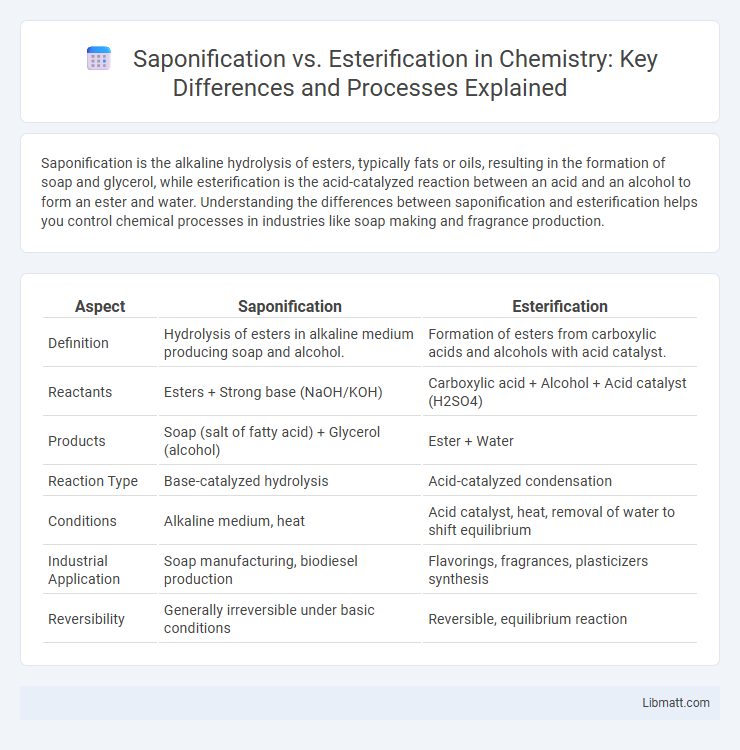Saponification is the alkaline hydrolysis of esters, typically fats or oils, resulting in the formation of soap and glycerol, while esterification is the acid-catalyzed reaction between an acid and an alcohol to form an ester and water. Understanding the differences between saponification and esterification helps you control chemical processes in industries like soap making and fragrance production.
Table of Comparison
| Aspect | Saponification | Esterification |
|---|---|---|
| Definition | Hydrolysis of esters in alkaline medium producing soap and alcohol. | Formation of esters from carboxylic acids and alcohols with acid catalyst. |
| Reactants | Esters + Strong base (NaOH/KOH) | Carboxylic acid + Alcohol + Acid catalyst (H2SO4) |
| Products | Soap (salt of fatty acid) + Glycerol (alcohol) | Ester + Water |
| Reaction Type | Base-catalyzed hydrolysis | Acid-catalyzed condensation |
| Conditions | Alkaline medium, heat | Acid catalyst, heat, removal of water to shift equilibrium |
| Industrial Application | Soap manufacturing, biodiesel production | Flavorings, fragrances, plasticizers synthesis |
| Reversibility | Generally irreversible under basic conditions | Reversible, equilibrium reaction |
Introduction to Saponification and Esterification
Saponification is a chemical reaction where a fat or oil reacts with a strong base, typically sodium hydroxide, producing glycerol and soap. Esterification involves the reaction between an acid, often a carboxylic acid, and an alcohol, resulting in the formation of an ester and water. Both processes are essential in organic chemistry and industrial applications, with saponification primarily used in soap making and esterification in producing fragrances, plastics, and pharmaceuticals.
Defining Saponification: The Soap-Making Reaction
Saponification is the chemical reaction where fats or oils react with a strong base, typically sodium hydroxide, to produce glycerol and soap, which are salts of fatty acids. This process contrasts with esterification, where an acid and an alcohol combine to form an ester and water. Understanding saponification is crucial for your knowledge of soap production and how it converts triglycerides into cleansing agents.
Understanding Esterification: The Formation of Esters
Esterification is a chemical reaction where a carboxylic acid reacts with an alcohol, producing an ester and water through a condensation process. This reaction typically requires an acid catalyst, such as sulfuric acid, to drive the formation of the ester by protonating the carbonyl group, enhancing its electrophilicity. Understanding esterification is crucial for synthesizing various esters used in flavors, fragrances, and biodegradable polymers.
Chemical Equations: Saponification vs Esterification
Saponification involves the hydrolysis of an ester under basic conditions, typically represented by the equation: ester + NaOH - soap (salt of fatty acid) + alcohol. Esterification is the acid-catalyzed reaction between a carboxylic acid and an alcohol, described by the equation: carboxylic acid + alcohol = ester + water. Your understanding of these chemical equations is essential for mastering reactions in organic chemistry and industrial applications.
Reaction Mechanisms Compared
Saponification involves the hydrolysis of esters under basic conditions, where hydroxide ions attack the carbonyl carbon, breaking the ester bond to produce a carboxylate salt and an alcohol. Esterification, conversely, is an acid-catalyzed condensation reaction between a carboxylic acid and an alcohol, forming an ester and water through protonation of the carbonyl oxygen and nucleophilic attack. Your understanding of these mechanisms highlights how nucleophilic acyl substitution governs both reactions but proceeds in opposite directions under different conditions.
Key Differences in Process and Conditions
Saponification involves the hydrolysis of esters in the presence of a strong base, typically sodium hydroxide or potassium hydroxide, resulting in the formation of soap and glycerol under alkaline conditions. Esterification is the acid-catalyzed reaction between a carboxylic acid and an alcohol, usually requiring sulfuric acid as a catalyst and heat to produce an ester and water. While saponification is a base-driven, irreversible process occurring at moderate temperatures, esterification is acid-driven, reversible, and often performed under reflux to shift equilibrium toward ester formation.
Industrial Applications of Saponification
Saponification plays a crucial role in the industrial production of soaps by converting triglycerides and alkali into glycerol and soap molecules, making it essential for the personal care and cleaning products sectors. Your manufacturing processes benefit from the efficiency of saponification in creating high-quality soaps, detergents, and emulsifiers widely used across multiple industries, including cosmetics and pharmaceuticals. This reaction's ability to produce biodegradable and effective cleansing agents positions it as a key chemical technique in sustainable industrial applications.
Industrial Applications of Esterification
Esterification plays a crucial role in industrial applications by producing esters used as solvents, plasticizers, and flavoring agents, significantly impacting the manufacture of polymers, paints, and fragrances. This reaction converts fatty acids and alcohols into valuable esters, which are vital in producing biodiesel and pharmaceuticals. Understanding esterification's industrial relevance helps optimize your processes for better efficiency and product quality.
Importance in Food, Pharmaceuticals, and Cosmetics
Saponification and esterification play crucial roles in food, pharmaceuticals, and cosmetics by influencing product formulation and functionality. Saponification is essential in producing soaps and cleansing agents, enhancing skin and hair care products' effectiveness. Esterification forms esters used as flavorings, fragrances, and active pharmaceutical ingredients, directly impacting product quality and sensory appeal for your needs.
Summary: Choosing Between Saponification and Esterification
Saponification involves the hydrolysis of esters under alkaline conditions to produce soap and glycerol, making it ideal for cleaning products and biodiesel. Esterification is the acid-catalyzed reaction between carboxylic acids and alcohols to form esters and water, commonly used in fragrance, flavor, and polymer industries. The choice between saponification and esterification depends on the desired product: soap or biodiesel favors saponification, while producing esters for solvents, plasticizers, or fragrances requires esterification.
saponification vs esterification Infographic

 libmatt.com
libmatt.com